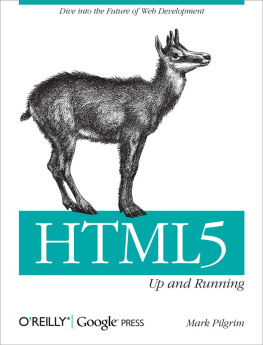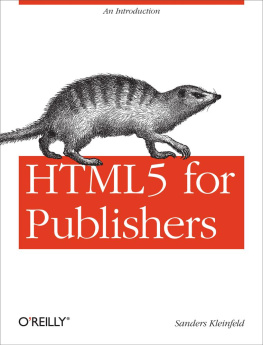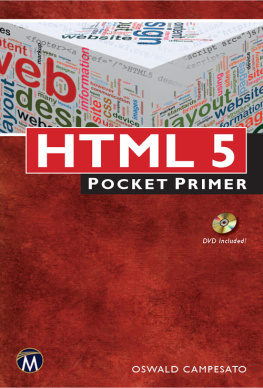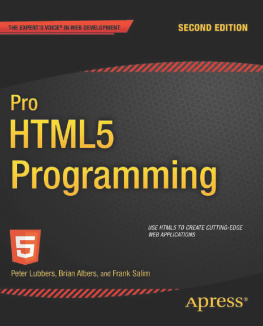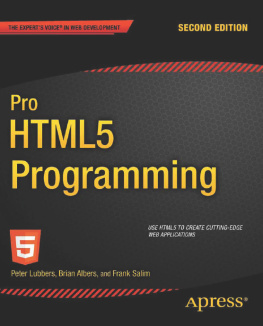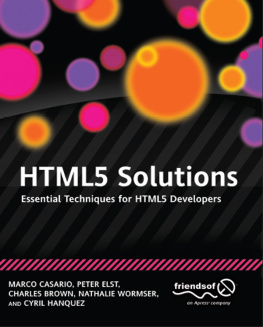Anthony T. Holdener III - HTML5 Geolocation
Here you can read online Anthony T. Holdener III - HTML5 Geolocation full text of the book (entire story) in english for free. Download pdf and epub, get meaning, cover and reviews about this ebook. year: 2011, publisher: OReilly Media, genre: Computer. Description of the work, (preface) as well as reviews are available. Best literature library LitArk.com created for fans of good reading and offers a wide selection of genres:
Romance novel
Science fiction
Adventure
Detective
Science
History
Home and family
Prose
Art
Politics
Computer
Non-fiction
Religion
Business
Children
Humor
Choose a favorite category and find really read worthwhile books. Enjoy immersion in the world of imagination, feel the emotions of the characters or learn something new for yourself, make an fascinating discovery.

- Book:HTML5 Geolocation
- Author:
- Publisher:OReilly Media
- Genre:
- Year:2011
- Rating:4 / 5
- Favourites:Add to favourites
- Your mark:
- 80
- 1
- 2
- 3
- 4
- 5
HTML5 Geolocation: summary, description and annotation
We offer to read an annotation, description, summary or preface (depends on what the author of the book "HTML5 Geolocation" wrote himself). If you haven't found the necessary information about the book — write in the comments, we will try to find it.
HTML5 Geolocation — read online for free the complete book (whole text) full work
Below is the text of the book, divided by pages. System saving the place of the last page read, allows you to conveniently read the book "HTML5 Geolocation" online for free, without having to search again every time where you left off. Put a bookmark, and you can go to the page where you finished reading at any time.
Font size:
Interval:
Bookmark:
"/>
Copyright 2011 Anthony T. Holdener, III
OReilly books may be purchased for educational, business, or sales promotional use. Online editions are also available for most titles (.
Nutshell Handbook, the Nutshell Handbook logo, and the OReilly logo are registered trademarks of OReilly Media, Inc. HTML5 Geolocation , the image of a cape petrel, and related trade dress are trademarks of OReilly Media, Inc.
Many of the designations used by manufacturers and sellers to distinguish their products are claimed as trademarks. Where those designations appear in this book, and OReilly Media, Inc. was aware of a trademark claim, the designations have been printed in caps or initial caps.
While every precaution has been taken in the preparation of this book, the publisher and authors assume no responsibility for errors or omissions, or for damages resulting from the use of the information contained herein.

To Kate and Tony: Remember to take the road less traveled in life, and bring along a good GPS device just in case.
This book explores the W3C Geolocation API , a specification that provides scripted access to geographical location information associated with a hosted device.[] This API defines objects that can be used in JavaScript to ascertain the position of the device on which the code is executed.
The term geolocation may refer to the act of identifying a persons position, or it may refer to the actual location itself.
The W3C Geolocation API brings incredible functionality to the browser. Previously, geolocation services were only made available by developers who were writing geolocation applications natively for a particular device. Now, developers have the freedom to write geolocation applications for the Web directly in the browser, and these applications have the advantage of the write once, deploy everywhere application model.
What Is with the Title?
Before I proceed, I would like to apologize for the title: HTML5 Geolocation . The Geolocation API is not technically a part of the W3Cs HTML5 Specification, so calling it the HTML5 Geolocation API is just plain wrong and I know it.
That being said, I challenge any of you to run a Google search for Geolocation API or HTML5 APIs and see how many of the hits you get have HTML5 Geolocation as the title. As you will find, there are very few results besides the actual W3C Geolocation API Working Draft , which omits the HTML5 part. Furthermore, I attended several JavaScript sessions at the 2011 Esri Developer Summit in Palm Springs, California, and every presenter speaking about the Geolocation API also used HTML5 in conjunction with it. Every single one. These people know their Geographic Information Systems (GIS). They live and breathe it, and they happen to work for the leading GIS software company in the world.
The simple fact is that we associate HTML5 and Geolocation. So to avoid any confusion that might have arisen had I not used HTML5, and since neither myself nor my editor could really come up with a snazzier title for this book, HTML5 Geolocation stuck.
This book is intended for developers interested in using the W3C Geolocation API in their web applications. The first few chapters delve into what geolocation is, its history, and how it is currently being utilized today.
These first chapters of the book are a crash course in geolocation to provide a framework for understanding what the API is about. If you are already in the GIS industry and just want to know how to implement this new Application Programming Interface (API) in your applications, or already know all there is to know about geolocation, then skip ahead to to see the API in action.
Developers should be particularly interested in ties things up by exploring what the future of geolocation holds for us all, and discusses practical applications for development using the Geolocation API.
[.
The following typographical conventions are used in this book:
Indicates new terms, URLs, email addresses, filenames, and file extensions.
Constant widthUsed for program listings, as well as within paragraphs to refer to program elements such as variable or function names, databases, data types, environment variables, statements, and keywords.
Constant width boldShows commands or other text that should be typed literally by the user.
Constant width italicShows text that should be replaced with user-supplied values or by values determined by context.
This icon signifies a tip, suggestion, or general note.
This icon indicates a warning or caution.
This book is here to help you get your job done. In general, you may use the code in this book in your programs and documentation. You do not need to contact us for permission unless youre reproducing a significant portion of the code. For example, writing a program that uses several chunks of code from this book does not require permission. Selling or distributing a CD-ROM of examples from OReilly books does require permission. Answering a question by citing this book and quoting example code does not require permission. Incorporating a significant amount of example code from this book into your products documentation does require permission.
We appreciate, but do not require, attribution. An attribution usually includes the title, author, publisher, and ISBN. For example: HTML5 Geolocation by Anthony T. Holdener III (OReilly). Copyright 2011 Anthony T. Holdener, III, 978-1-449-30472-0.
If you feel your use of code examples falls outside fair use or the permission given above, feel free to contact us at .
Safari Books Online is an on-demand digital library that lets you easily search over 7,500 technology and creative reference books and videos to find the answers you need quickly.
With a subscription, you can read any page and watch any video from our library online. Read books on your cell phone and mobile devices. Access new titles before they are available for print, and get exclusive access to manuscripts in development and post feedback for the authors. Copy and paste code samples, organize your favorites, download chapters, bookmark key sections, create notes, print out pages, and benefit from tons of other time-saving features.
OReilly Media has uploaded this book to the Safari Books Online service. To have full digital access to this book and others on similar topics from OReilly and other publishers, sign up for free at http://my.safaribooksonline.com.
Please address comments and questions concerning this book to the publisher:
| OReilly Media, Inc. |
| 1005 Gravenstein Highway North |
| Sebastopol, CA 95472 |
| 800-998-9938 (in the United States or Canada) |
| 707-829-0515 (international or local) |
| 707-829-0104 (fax) |
We have a web page for this book, where we list errata, examples, and any additional information. You can access this page at:
Font size:
Interval:
Bookmark:
Similar books «HTML5 Geolocation»
Look at similar books to HTML5 Geolocation. We have selected literature similar in name and meaning in the hope of providing readers with more options to find new, interesting, not yet read works.
Discussion, reviews of the book HTML5 Geolocation and just readers' own opinions. Leave your comments, write what you think about the work, its meaning or the main characters. Specify what exactly you liked and what you didn't like, and why you think so.


